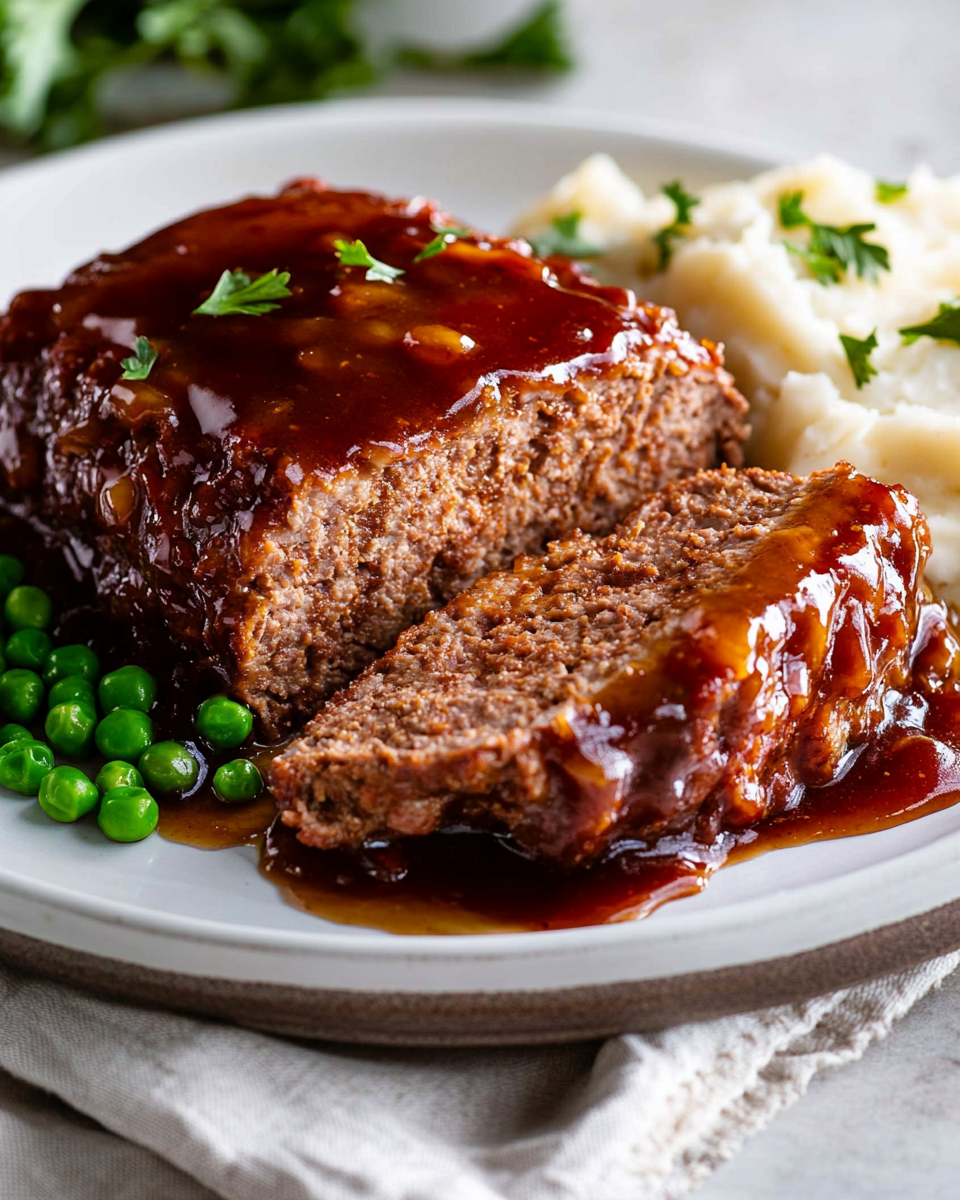This Classic Meatloaf with Brown Sugar Glaze is the ultimate comfort food—moist, tender, and bursting with savory flavor. The sweet and tangy glaze caramelizes perfectly over the meat, making every bite irresistible. It’s a hearty, satisfying dinner perfect for any weeknight or family gathering.
FULL RECIPE
Ingredients
1.For the Meatloaf:
- 1 ½ pounds ground beef (80/20 blend)
- 1 cup milk
- 1 cup breadcrumbs
- 2 large eggs
- 1 small onion, finely chopped
- 2 cloves garlic, minced
- 2 tablespoons Worcestershire sauce
- 1 tablespoon ketchup
- 1 teaspoon salt
- ½ teaspoon black pepper
- ½ teaspoon dried thyme
2.For the Brown Sugar Glaze:
- ⅓ cup ketchup
- 2 tablespoons brown sugar
- 1 tablespoon Dijon mustard
- 1 tablespoon apple cider vinegar
Directions
- Preheat your oven to 350°F (175°C). Lightly grease a loaf pan or line with parchment paper.
- In a large mixing bowl, combine ground beef, milk, breadcrumbs, eggs, onion, garlic, Worcestershire sauce, ketchup, salt, pepper, and thyme. Mix until just combined—do not overmix.
- Press the meat mixture evenly into the prepared loaf pan.
- In a small bowl, whisk together ketchup, brown sugar, Dijon mustard, and apple cider vinegar for the glaze.
- Spread half the glaze over the top of the meatloaf.
- Bake for 45 minutes, then remove from the oven and spread the remaining glaze on top.
- Return to the oven and bake for an additional 15-20 minutes, or until the internal temperature reaches 160°F (71°C).
- Let the meatloaf rest for 10 minutes before slicing and serving.
Nutritional Information
- Calories: 370 per slice (1/8th of loaf)
- Total Fat: 21g
- Saturated Fat: 8g
- Cholesterol: 120mg
- Sodium: 610mg
- Total Carbohydrates: 18g
- Dietary Fiber: 1g
- Sugars: 7g
- Protein: 27g
- Vitamin A: 4% DV
- Vitamin C: 4% DV
- Calcium: 6% DV
- Iron: 15% DV
History of Meatloaf
Meatloaf is a classic dish with roots tracing back to Europe, particularly Germany and Scandinavia, where minced meat mixed with fillers was a common way to stretch ingredients. It gained widespread popularity in America during the Great Depression when affordable cuts of meat and pantry staples were combined to create a hearty, economical meal. Over time, meatloaf evolved with regional variations, becoming a beloved comfort food staple across many households.
Why Ground Beef Works Best
Ground beef is traditionally used in meatloaf because of its rich flavor and fat content, which keeps the loaf moist and tender during cooking. The ideal blend is usually 80% lean to 20% fat, balancing taste and juiciness. Leaner meats often result in a drier texture, while fattier blends produce a more flavorful dish. Some recipes incorporate ground pork or veal to enhance the flavor profile, but beef remains the classic choice.
The Role of Breadcrumbs and Milk
Breadcrumbs and milk act as binders and moisture enhancers in the meatloaf mixture. Breadcrumbs absorb the milk, creating a soft, sponge-like texture that holds the loaf together without becoming dense or tough. This combination prevents the meatloaf from crumbling and ensures a tender bite. Using fresh breadcrumbs or soaked bread can also influence the texture and moisture level.
Eggs as a Binder
Eggs are a crucial ingredient in meatloaf, providing structure and stability. They help bind the meat and other ingredients together, preventing the loaf from falling apart during baking and slicing. The proteins in eggs coagulate with heat, solidifying the loaf’s shape. Skipping eggs or using too few can lead to a crumbly texture that lacks cohesion.
Onion and Garlic: Flavor Foundations
Onions and garlic form the aromatic base of many meatloaf recipes, adding depth and savoriness to the dish. Finely chopped onions release sweetness and moisture during cooking, balancing the richness of the meat. Garlic adds a sharp, pungent note that complements the beef without overpowering it. Together, they elevate the overall flavor complexity.
The Science Behind the Brown Sugar Glaze
The brown sugar glaze is more than just a topping—it adds a glossy finish and a delightful balance of sweet and tangy flavors. When baked, the sugars caramelize, creating a slightly sticky crust that contrasts with the tender meat inside. The combination of ketchup, mustard, vinegar, and brown sugar provides acidity and sweetness that enhances the meatloaf’s richness.
Tips for Achieving the Perfect Texture
Achieving the ideal meatloaf texture requires careful mixing and ingredient ratios. Overworking the meat mixture can cause it to become dense and tough, while under-mixing might lead to uneven seasoning and crumbly slices. It’s best to gently combine ingredients until just incorporated. Additionally, not packing the loaf too tightly allows for better heat circulation and a lighter final texture.
How to Test for Doneness
Ensuring meatloaf is fully cooked but still moist is key. Using a meat thermometer is the most reliable method—an internal temperature of 160°F (71°C) indicates safe doneness for ground beef. Overcooking leads to dryness, while undercooking poses health risks. Allowing the meatloaf to rest after baking lets juices redistribute, improving moisture retention and ease of slicing.
Serving Suggestions
Classic meatloaf pairs beautifully with a variety of side dishes, making it a versatile dinner option. Traditional accompaniments include mashed potatoes, steamed vegetables, or green beans. For a lighter approach, serve with a fresh garden salad or roasted root vegetables. Leftovers can be repurposed into hearty sandwiches or even crumbled into pasta sauces for added flavor.
Variations and Customizations
Meatloaf is incredibly adaptable. You can customize it by adding different herbs, spices, or vegetables like bell peppers, mushrooms, or shredded carrots. Some recipes incorporate cheese inside the loaf or on top for added richness. For a healthier twist, substitute ground turkey or chicken and use whole-grain breadcrumbs. The glaze can also be varied with barbecue sauce, chili sauce, or even maple syrup.
Nutritional Considerations
While meatloaf is a protein-rich meal, it can also be high in fat and sodium depending on the recipe. Using leaner meat, reducing salt, and controlling the amount of sugary glaze can make it healthier. Incorporating vegetables into the mix increases fiber content. Understanding these factors helps balance flavor with nutrition for a well-rounded meal.
Make-Ahead and Storage Tips
Meatloaf is excellent for meal prep as it holds up well in the refrigerator and freezer. You can assemble the loaf ahead of time and refrigerate it for up to 24 hours before baking to deepen flavors. Leftovers should be cooled and stored in an airtight container for up to 4 days or frozen for 2-3 months. Reheat gently to maintain moisture and texture.
Cultural Significance and Popularity
Meatloaf has earned a place as a comfort food icon in American cuisine and beyond. Its simplicity and adaptability have made it a household favorite through generations. From classic diner menus to homemade family dinners, meatloaf represents warmth, nostalgia, and the art of humble ingredients made delicious.
Conclusion
Classic meatloaf with brown sugar glaze is much more than just a simple dish; it’s a culinary tradition filled with history, science, and versatility. From its humble beginnings to its place on dinner tables today, this recipe showcases how basic ingredients can come together to create a meal that’s both comforting and flavorful. Understanding its components and preparation techniques helps home cooks perfect their own versions, making meatloaf a timeless staple in the kitchen.






